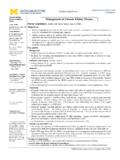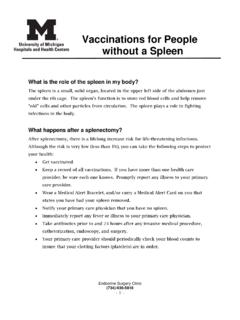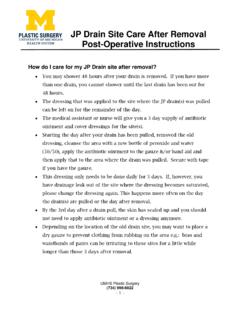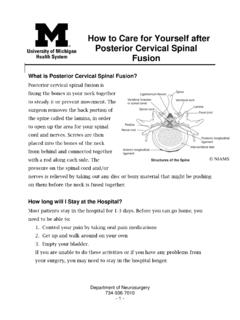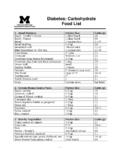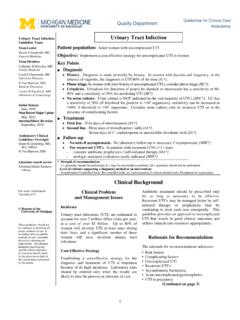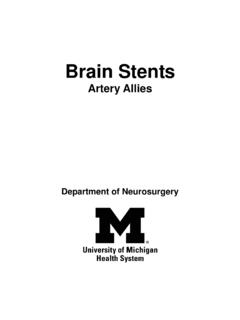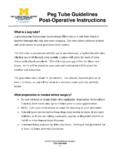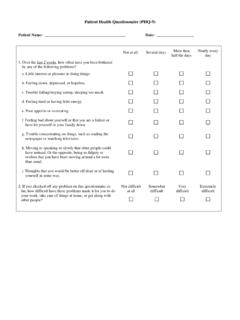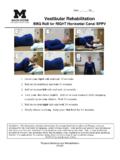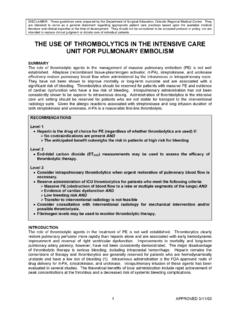Transcription of Atrial Fibrillation Management of Acute Atrial ...
1 Quality Department Guidelines for Clinical Care Inpatient Atrial Fibrillation Guideline Team Management of Acute Atrial Fibrillation and Atrial Team Members Flutter in Non-Pregnant Hospitalized Adults Jeffrey M Rohde, MD. (Team Lead) Patient Population. Adult hospitalized patients with Atrial Fibrillation and Flutter. This guideline Internal Medicine excludes pregnant women. Sarah E Hartley, MD. Internal Medicine Objectives. The purpose of these inpatient care guidelines is to provide an evidence-based blue print Sarah Hanigan, PharmD for the Acute care of patients with Atrial Fibrillation (AF) and Atrial flutter (AFL) at the University of Pharmacy Services Michigan Health System.
2 It is hoped that this standardization of care will result in improved patient Jules Lin, MD outcomes, shorter length of hospital stay, lower readmission rates, and overall cost savings for the Thoracic Surgery system. This document will discuss evaluation of patients with new onset and recurrent AF/AFL, Lewis B Morgenstern, MD including indications for admission, rate vs. rhythm control strategies, and plan of care following Neurology (Stroke). patient's discharge. F Jacob Seagull, PhD. Medical Education David M Somand, MD. Key Points Emergency Medicine Clinical Presentation David H Wesorick, MD Patients presenting with palpitations, irregular pulse, chest pain, dyspnea, fatigue, lightheadedness, Internal Medicine syncope, cardio-embolic disease and new or recurrent heart failure should be evaluated for AF/AFL.
3 James B Froehlich MD While AF may be asymptomatic and found incidentally, AFL is usually highly symptomatic. (Consultant). Cardiology Diagnosis Thomas C Crawford, MD Electrocardiogram (ECG) is essential in the diagnosis of AF/AFL. The initial evaluation is summarized (Team Lead) in Table 1 and should include: Cardiology Physical exam Initial Release: Laboratory evaluation: CBC, basic metabolic profile, magnesium, thyroid-stimulating hormone, May, 2014 and cardiac enzymes as indicated Last Reviewed: Imaging: Chest X-ray, echocardiogram June, 2017. Continuous telemetry monitoring in the hospital Treatment Inpatient Clinical Guidelines Oversight Initial treatment of AF/AFL depends on hemodynamic stability: Sarah E Hartley, MD.
4 David H Wesorick, MD Unstable AF/AFL (Figure 1). F Jacob Seagull, PhD. Begin resuscitation and consider other conditions contributing to instability If instability due to AF/AFL - immediate direct current cardioversion Stable AF/AFL (Figure 2): For more information: 734- 936-0770 For ED patients: Screen for early cardioversion in the Emergency Department (Figure 4). Administer rate controlling agents as indicated (Table 4) [I, B]. - EP consult for uncontrolled rate despite adequate trial of rate controlling agents Consider the appropriateness of a rhythm control strategy (Table 3) [I, B]. Regents of the - If rhythm control strategy is appropriate/desired, consult EP and start immediate University of Michigan anticoagulation (Figure 3).
5 Consider anticoagulation based on CHA2DS2-VASc score (Table 2, Figure 3) [I, A]. - The choice of anticoagulant will depend on the patients clinical circumstances and renal function (Figure 3). These guidelines should not be - Obtain Neurology consult prior to initiation of anticoagulation for patients with recent construed as including all proper methods of care or ischemic stroke within the prior two weeks excluding other acceptable - Patients with valvular disease and those requiring concomitant treatment with dual methods of care reasonably directed to obtaining the same antiplatelet therapy should be anticoagulated with warfarin results.
6 The ultimate judgment - Target-specific oral anticoagulants are preferred over warfarin in many cases regarding any specific clinical procedure or treatment must be * Strength of recommendation: made by the physician in light I = generally should be performed; II = may be reasonable to perform; III = generally should not be performed. of the circumstances presented Levels of evidence reflect the best available literature in support of an intervention or test: by the patient. A=randomized controlled trials; B=controlled trials, no randomization; C=observational trials; D=opinion of expert panel.
7 Figure 1: Acute Management of UNSTABLE Atrial Fibrillation and Atrial flutter (AF/AFL). ACS: Acute coronary syndrome; BNP: Brain natriuretic peptide; CBC: complete blood count; CCU: Cardiac Care Unit; COMP: comprehensive metabolic panel; CXR: chest radiograph; ECG: electrocardiogram; EP: electrophysiology; HR: heart rate; IV: intravenous; J: Joules; PE: Pulmonary embolism; RRT: rapid response team; SBP: systolic blood pressure; TSH: thyroid stimulating hormone; UA: urinalysis. Figure 2: Acute Management of STABLE Atrial Fibrillation and Atrial flutter with rapid ventricular response1. 2. See Figure 2 notes on following page 3.
8 Figure 2 Notes: 1. If BP does not tolerate these medications, see Table 4 (medications for rate control) and consider DCCV or EP/General Cardiology consult. Also, IV calcium channel blockers and IV beta blockers are not usually combined- if one is not effective, change to the other. 2. If patient spontaneously converts to normal sinus rhythm: If in the ED, provide outpatient EP follow-up within 2 weeks If inpatient, consider consulting EP in the hospital If a postoperative patient, consult General Cardiology (if AF/AFL is sustained for > 24 hours). Consider a rate control agent (Table 4), depending on the pre- and post-conversion heart rate Consider the use of a 3 week event monitor after discharge to identify paroxysmal AF/AFL.
9 In all cases, consider anticoagulation (see Table 2 and Figure 3). 3. For patients with decompensated systolic heart failure: Consult cardiology, and consider digoxin or amiodarone for rate control. AV: atrioventricular; CAD: coronary artery disease; ECG: electrocardiogram; EP: electrophysiology; HR: heart rate; IV: intravenous; LV: left ventricular; WPW: Wolff Parkinson White. 4. Figure 3: Management of anticoagulation therapy in Atrial Fibrillation and Atrial flutter1. 5. Figure 4: Emergency Department screening for early cardioversion of Atrial Fibrillation and Atrial flutter CrCl: creatinine clearance; SBP: Systolic blood pressure.
10 6. Table 1: Diagnostic evaluation of Atrial Fibrillation and Atrial flutter Current electrocardiogram (ECG). Complete physical exam Current Basic Metabolic Panel, Magnesium, complete blood count (CBC). Current thyroid stimulating hormone (TSH). Chest X-ray (CXR). Serial cardiac enzymes (Troponin, CK, CK-MB) as indicated Continuous telemetry monitoring Echo within the past 6 months to assess for the presence and severity of structural heart disease Table 2: CHA2DS2 VASc score and annual stroke risk C Congestive heart failure (or Left ventricular systolic 1 CHA2DS2-VASc Stroke Risk dysfunction) Score (%/year).
